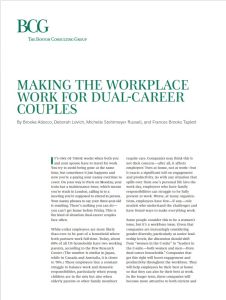
Brooke Allocco, Deborah Lovich, Michelle Stohlmeyer Russell and Frances Brooks Taplett
Making the Workplace Work for Dual-Career Couples
Boston Consulting Group, 2018
What's inside?
Happy parents are happy employees. To get the most out of your employees with families, help them succeed at home.
Recommendation
When both parents work, completing mundane tasks – such as going to a piano recital, taking the kids to school or caring for your sick child – can become daunting challenges of coordination. Brooke Allocco, Deborah Lovich, Michelle Stohlmeyer Russell and Frances Brooks Taplett – senior staffers at the Boston Consulting Group – advocate supporting dual-career families to help your employees thrive at work. Their article may be an eye opener for those managers who don’t yet understand why their employees with families look like they’ve done a day’s worth of work by the time they show up at the office.
Take-Aways
- Around six in ten American households have two working parents. Companies that want to retain talent should be attentive to their needs.
- Dual-career households are becoming more common as women work in a wider variety of jobs and as the cost of living for families often requires two incomes.
- Employers can support dual-career households by creating more flexible work conditions. Executives should role-model taking advantage of such programs.
- Companies should adopt a broad view of a successful career and support alternative paths like part-time work or mid-career breaks.
- Companies that back workers from dual-career households benefit in terms of employee engagement, productivity and retention.
Summary
Around six in ten American households have two working parents. Dual-career households are becoming more common as women work a wider variety of jobs and as families require two incomes to cover the costs of living. Millennial men, especially, want to take on more active roles at home. However, many working parents step away from professional aspirations or even drop out of the workforce worrying that they can’t balance the responsibilities at home and at work. One study showed that 60% of nonworking parents don’t work because they don’t have adequate child care. The consequence is that companies may not employ and promote the best-qualified people.
“White-collar employees are more likely than ever to be part of a household where both partners work full-time.”
Companies that want to attract and keep talented workers with families need to be more attentive to their needs. Child-rearing – or looking after one’s elderly parents – isn’t just a home issue. People’s family lives affect their work quality, and often employees have few professional role models who balance their work and personal lives effectively. Organizations also need to make their policies inclusive of senior executives from dual-career households regardless of gender. Companies can support employees from dual-career households with a flexible work environment, which may include remote work options or adjustable hours. The Oman-based financial-services company Bank Muscat, for example, has all of its staff work from 8 a.m. to 2 p.m. but lets them set their own hours from then on.
“Allowing employees to work under flexible terms – as long as they get their work done – is a huge opportunity.”
Workplace cultures become friendlier to working parents when they “reward results, not face time.” Companies must push executives to take advantage of flexible job programs like paternity leave, which can also encourage lower-level employees to do so. Workers shouldn’t lose out on professional opportunities even if they work part-time or change roles at the company. Finally, companies should lay the groundwork to support dual-career colleagues in the long term. They should establish gender-neutral programs such as onsite child care and paid parental leave. Technology like videoconferencing can aid workers with flexible work locations and schedules. Watching out for workers in dual-career households takes effort, but it’s a worthy investment that has “a significant payoff in terms of engagement, productivity, recruiting and retention.”
About the Authors
Brooke Allocco, Deborah Lovich, Michelle Stohlmeyer Russell and Frances Brooks Taplett are senior staff members at Boston Consulting Group, an international consulting firm.
This document is restricted to personal use only.
My Highlights
Did you like this summary?
Read the articleThis summary has been shared with you by getAbstract.
We find, rate and summarize relevant knowledge to help people make better decisions in business and in their private lives.
Already a customer? Log in here.

























Comment on this summary